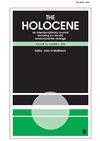巴西东南部的考古和现代白口黄花鱼:环境偏好的地球化学代表
IF 1.8
3区 地球科学
Q3 GEOGRAPHY, PHYSICAL
引用次数: 0
摘要
本研究采用激光烧蚀-电感耦合等离子体-质谱法研究了巴西东南部海涌影响下家具小虫耳石的生长模式。从巴西贝丘(5820-4980)中发现的M.furnieri的考古鱼类箭形耳石 cal-BP)进行了分析,并与现代标本进行了比较。耳石Sr/Ca分析表明,在巴西东南部海域,弗尼耶里M.furnieri从考古标本中的淡水/半咸水转变为现代的半咸水/海洋。有规律的核心到边缘Sr/Ca振荡表明,现代和考古的弗尼里M.furnieri都是常驻河口鱼类,也使用海岸带附近的海水。根据对考古样本中测得的广泛耳石边缘Sr/Ca值的分析,瓜纳巴拉湾沿海地区的殖民前捕鱼活动全年都在发生。这项研究强化了弗尼里M.furnieri作为该地区殖民前捕鱼资源的重要性,并表明了捕鱼方式的转变,即在海湾内以较小的鱼类为目标,在海湾外捕捞较大的鱼类。这些数据也可能表明该物种的生命周期发生了变化,可能是由于对这一重要资源的过度捕捞和现代受保护沿海水域人类活动的显著增加造成的。本文章由计算机程序翻译,如有差异,请以英文原文为准。
Archaeological and modern whitemouth croaker fish (Micropogonias furnieri) of southeastern Brazil: A geochemical proxy for environmental preference
In this study, laser ablation–inductively coupled plasma–mass spectrometry was used to characterize the growth patterns of otolith of Micropogonias furnieri from southeastern Brazil under the influence of coastal marine upwelling. Archaeological fish sagittae otoliths of M. furnieri recovered from Brazilian shell mounds (5820‒4980 cal BP) were analysed and compared with those of modern specimens. Otolith Sr/Ca analysis indicated that off southeastern Brazil, M. furnieri shifted from freshwater/brackish in archaeological specimens to brackish/marine in modern times. Regular core-to-edge Sr/Ca oscillations suggest that both modern and archaeological M. furnieri are resident estuarine fish that also use the marine waters adjacent to the coastal zone. Based on analyses of a wide range of otolith edge Sr/Ca values measured in archaeological samples, pre-colonial fishing activities in the coastal regions of Guanabara Bay occurred throughout the year. This study reinforces the importance of M. furnieri as a precolonial fishing resource in this area and demonstrates a shift in fishing practices, where smaller fish are targetted within the bay and larger fish are caught beyond the bay. These data may also be indicative of a shift in the life cycle of this species, possibly caused by the overfishing of this important resource and significant increase in human activities in protected coastal waters in modern times.
求助全文
通过发布文献求助,成功后即可免费获取论文全文。
去求助
来源期刊

Holocene
地学-地球科学综合
CiteScore
4.70
自引率
8.30%
发文量
106
审稿时长
4 months
期刊介绍:
The Holocene is a high impact, peer-reviewed journal dedicated to fundamental scientific research at the interface between the long Quaternary record and the natural and human-induced environmental processes operating at the Earth''s surface today. The Holocene emphasizes environmental change over the last ca 11 700 years.
 求助内容:
求助内容: 应助结果提醒方式:
应助结果提醒方式:


